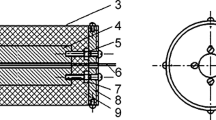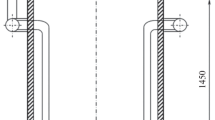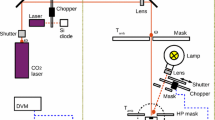Abstract
This paper presents an experimental methodology for measuring the incident radiation heat flux distribution surrounding a jet fire. The methodology uses a line of surface thermocouples attached to a steel bar. The thermocouples measure the temperature time history of the steel bar in response to an imposed incident radiation heat flux. The theoretical basis of the methodology is an energy balance for any point on the steel bar. The energy balance is formulated as a lumped capacitance model. All of the assumptions in the theory are shown to be valid and the accuracy of the experimental methodology demonstrated.








Similar content being viewed by others
Abbreviations
- Bi :
-
Biot number
- c steel :
-
Specific heat capacity of steel
- C1, C2:
-
Turbulence model constants
- D :
-
Burner diameter
- E n :
-
Root mean squared difference between measured and predicted temperature
- Fr :
-
Froude number
- g :
-
Gravitational acceleration
- h :
-
Convective heat transfer coefficient
- I inc :
-
Incident intensity
- k steel :
-
Thermal conductivity of steel
- N :
-
Number of entries in a time series
- Nu :
-
Nusselt number
- q conv :
-
Convective heat flux
- q emit :
-
Emitted radiation heat flux
- q inc :
-
Incident radiation heat flux
- q refl :
-
Reflected radiation heat flux
- r :
-
Radial coordinate
- Ra :
-
Rayleigh number
- Re :
-
Reynolds number
- T :
-
Temperature
- T amb :
-
Bulk air temperature
- T i :
-
Initial temperature
- T m :
-
Measured temperature
- T n :
-
Predicted temperature at n∆t time
- T rise :
-
Dimensionless temperature rise
- T steady :
-
Steady state temperature
- t max :
-
Maximum time in temperature–time series
- U 0 :
-
Source velocity
- z :
-
Axial coordinate
- ∆ :
-
Thickness of steel bar
- ∆t :
-
Time step
- ∆Ω :
-
Field of view
- ∆q inc :
-
Uncertainty in the incident radiation heat flux
- ∆T :
-
Uncertainty in the temperature
- ∆ε :
-
Uncertainty in the surface emissivity
- ρ steel :
-
Density of steel
- θ :
-
Angle of incidence
- σ :
-
Stefan Boltzmann constant
- Ω :
-
Ray orientation
References
Jeng SM, Chen LD, Faeth GM (1982) The structure of buoyant methane and propane diffusion flames. In: Nineteenth symposium (international) on combustion. The Combustion Institute, Pittsburgh, pp 349–358
Jeng, S.M., Lai, M.C. and Faeth G.M., Nonluminous radiation in turbulent buoyant axisymmetric flames, Combust Sci and Tech., 1984, 40, 41-53.
Fairweather, M., Jones, W.P. and Lindstedt, R.P., Predictions of Radiative Heat Transfer from a Turbulent Reacting Jet in a Cross-Wind, Combust Flame, 1992, 89, 45-63.
Onokpe O. and Cumber P.S., (2009) Modelling lifted hydrogen jet fires using the boundary layer equations, J. Applied Thermal Engineering, 29: 1383-1390.
Cumber PS. and Spearpoint M. A computational flame length methodology for propane jet fires, Fire Safety Journal, 2007, 41, 215-228.
Cumber P.S., (2009) Accelerating ray convergence in jet fire radiation modelling using Sobol sequences, Int. J. Thermal Science, 48: 1338-1347.
Heat flux transducers and infrared radiometers for the direct measurement of heat transfer rates. Medtherm Corporation.
Cumber P.S. and Fairweather M., (2005) Evaluation of flame emission models combined with the discrete transfer method for combustion system simulation, Int J of Heat and Mass Transfer, 48: 5221-5239.
Ingason, H. and de Ris, J., Flame heat transfer in storage geometries, Fire Safety Journal, 1998, 31, 39-60.
Blanchat TK, Humphries LL, Gill W (2000) Sandia heat flux gauge thermal response and uncertainty models. Sandia National Laboratories Report SAND2000-1111
Ingason, H. and Wickstrom, U., Measuring incident radiant heat flux using the plate thermometer, Fire Safety Journal, 2007, 42, 161-166.
Nakos JT (2005) Uncertainty analysis of steady state incident heat flux measurements in hydrocarbon fuel fires. Sandia National Laboratories Report SAND2005-7144
Siegel, R. and Howell, J.R., Thermal Radiation Heat Transfer, 3rd Edition, Hemisphere Publishing Corporation, 1992.
Moran MJ, Shapiro HN, Munson BR, DeWitt DP (2003) Introduction to thermal systems engineering. Wiley, New York
Cumber P.S. and Passarelli K.S., (2007) The numerical analysis of precision quartz oscillator simulation – An area corrected flux finite volume scheme, J Num Heat Transfer Part B. 52: 201-230.
Press WH, Teukolsky SA, Vetterling WT, Flannery BP (1992) Numerical recipes in Fortran 77, 2nd edn. Cambridge University Press, New York
Jones, W.P. and Launder, B.E., The prediction of laminarization with a two-equation turbulence model, Int. J. Heat Mass Transfer, 1972, 15, 301-314.
Pope, S.B., An explanation of the turbulent round-jet/plane-jet anomaly, AIAA J, 1978, 16, 279-281.
Moss JB, Stewart CD, Syed K (1988) Flow field modelling of soot formation at elevated pressure. In: Twenty-second symposium (international) on combustion. The Combustion Institute, Pittsburgh, pp 413–423.
Fairweather M, Jones WP, Ledin S, Lindstedt P (1992) Predictions of soot formation in turbulent non-premixed propane flames. In: Twenty-second symposium (international) on combustion. The Combustion Institute, Pittsburgh, pp 1067–1074
Cumber P.S. and Spearpoint M., (2006) Modelling lifted methane jet fires using the boundary layer equations, J Num Heat Transfer Part B Fundamentals, 49: 239-258.
Chase MW, Davies CA, Downey JR, Frurip DJ, McDonald RA, Syverud AN (1985) JANAF thermochemical tables, vol 14, 3rd edn, J Phys Chem Ref Data
Lockwood FC, Shah NG (1981) A new radiation solution method for incorporation in general combustion prediction procedures. In: Eighteenth symposium (international) on combustion. The Combustion Institute, Pittsburgh, pp 1405–1414.
Cumber P.S., (1995) Improvements to the discrete transfer method of calculating radiative heat transfer, Int J of Heat and Mass Transfer, 38: 2251-2258.
Cumber P.S., (2000) Ray effect mitigation in jet fire radiation modelling, Int J of Heat and Mass Transfer, 43: 935-943.
Grosshandler, W.L., Radiative heat transfer in nonhomogeneous gases: A simplified approach, Int. J of Heat and Mass Transfer, 1980, 23, 1447-1459.
Cumber P.S., Fairweather M., and Ledin S., Application of wide band radiation models to non-homogeneous combustion systems, Int. J. Heat Mass Transfer, 41, (1998), 1573-1584.
Author information
Authors and Affiliations
Corresponding author
Rights and permissions
About this article
Cite this article
Cumber, P.S. Measuring Radiation Heat Fluxes from a Jet Fire Using a Lumped Capacitance Model. Fire Technol 47, 665–685 (2011). https://doi.org/10.1007/s10694-010-0182-9
Received:
Accepted:
Published:
Issue Date:
DOI: https://doi.org/10.1007/s10694-010-0182-9




